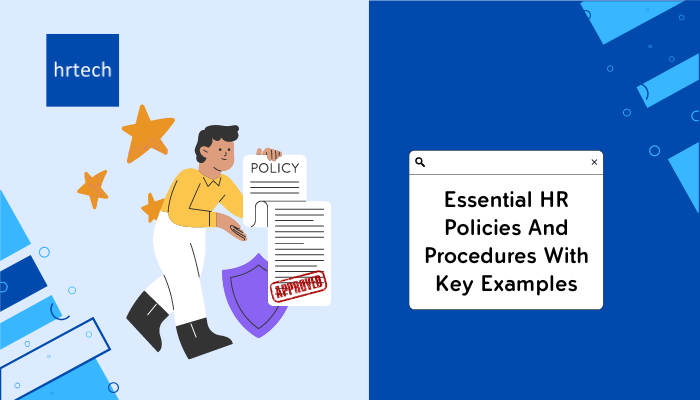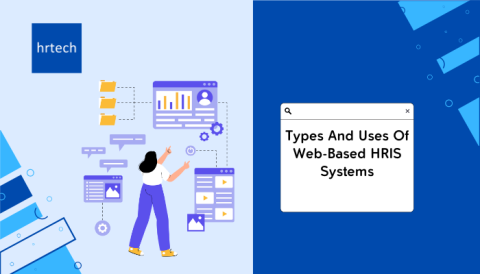Imagine losing your company’s best employees just because of improper HR policies.
Yes, you read that right!
But the good news is, it’s a problem that can be easily avoided.
How?
By properly implementing the right policies. In this guide, we’ll discuss all the essential HR policies that should be in any employee handbook. We will also outline what each policy means, what to include while preparing it and an example for each to help you get started.
Introduction To HR Policies And Procedures:
HR policies and procedures are essential for any successful organization. They guide employees and managers, making sure everyone understands workplace expectations, rights, and responsibilities.
HR policies shape your company’s culture and employee behavior. They define what is acceptable and what is not, from dress codes and attendance to social media use and confidentiality.
Clear expectations create fairness and consistency, making everyone feel treated equally.
Protect your company from legal issues.
Improve employee morale and job satisfaction by creating a safe, respectful workplace.
Simplify processes and boost efficiency with clear guidelines and procedures.
Attract and keep top talent by showing your commitment to employee well-being and growth.
Whether you have a small startup or a large corporation, creating strong HR policies is a wise investment. In the following sections, we will explore essential policies every business should have and provide examples to help you get started.
Compliance if you’re hiring globally can be tricky, and to avoid hassle – it’s worth looking into EOR (employer of record) and PEO solutions when looking to hire full time employees globally
Defining HR Policies And Procedures:
HR policies and procedures are formal, written guidelines on employment-related matters. They are official documents that explain how your organization handles various aspects of the employer-employee relationship.
An effective HR policy typically includes the following components:
It’s important to note that HR policies are distinct from corporate policies and guidelines. Corporate policies generally address broader, company-wide issues, while HR policies focus specifically on employee-related matters.
For example, a corporate policy might outline the company’s stance on environmental sustainability, while an HR policy would cover topics like employee conduct, benefits, and performance management. Check out hrtech’s comprehensive marketplace to find tools that help in drafting clear and comprehensive policies, making sure they align with your organizational goals.
Why HR Policies Are Essential?
HR policies are not just a set of rules to follow. They are crucial in protecting both the company and its employees. Here are some key reasons why HR policies are so important:
Legal Protection:
First and foremost, HR policies provide legal protection and clarity in employment conditions.
They ensure that everyone is on the same page regarding wages, benefits, and job duties. This helps prevent misunderstandings and disputes down the line.
Conflict-Resolution:
Secondly, HR policies provide a foundation for consistent decision-making and conflict resolution.
Did you know that 82% of employees find an absence of fairness in their work setting?
So, with proper HR policies, you can ensure that everyone knows the rules and expectations. And as a result, it becomes much easier to handle issues fairly and consistently. This in turn helps create a sense of trust and transparency in the workplace.
Safe And Healthy Working Environment:
HR policies also play a key role in promoting a safe and healthy working environment.
They outline procedures for things like workplace safety, harassment prevention, and accommodating disabilities. This not only protects employees but also helps prevent accidents and lawsuits.
Compliance With Regulations:
HR policies facilitate compliance with regulations and mitigate risks. They help ensure that your company follows all relevant laws and industry standards.
This is especially important in heavily regulated industries like healthcare and finance.
Transforming HR through Agile Workforce Solutions
Drafting Effective HR Policies:
Creating clear, comprehensive HR policies is crucial for any organization.
But what makes an HR policy effective? Let’s break it down.
First, your HR policies should include several key elements for clarity and compliance:
Purpose statement – Explain why the policy exists and its aims.
Scope – Clearly define who the policy applies to (e.g., all employees, specific departments).
Definitions – Clarify any technical terms or jargon used in the policy.
Procedures – Outline the steps involved in following the policy, including any necessary forms or documentation.
Consequences – Specify what happens if the policy is violated, such as disciplinary action or termination.
When writing HR policies, following best practices for clarity and organization is important.
It’s also essential to regularly review and update your HR policies to ensure they remain relevant and compliant with any changes in laws or regulations. Set a schedule for reviewing policies annually or bi-annually.
Pro-Tip: Use a standardized template for all your HR policies to ensure consistency and make them easier to navigate. Include sections like purpose, scope, definitions, procedures, and consequences.
When updates are made, communicate them clearly to all employees. Consider holding training sessions or Q&A forums to ensure everyone understands the changes. Also, provide opportunities for employees to ask questions and provide feedback.
Core HR Policy Categories:
HR policies cover various topics related to employment and the workplace. Let’s examine some of the core categories that every organization should address.
1. Employee conduct and workplace behavior:
- Code of conduct
- Dress code
- Social media use
- Confidentiality and non-disclosure agreements
2. Recruitment, hiring, and termination:
- Job posting and application process
- Interview and selection procedures
- Background checks and reference verification
- Onboarding and offboarding processes
3. Working hours, attendance, and remote work:
- Standard work hours and overtime policies
- Attendance and tardiness guidelines
- Remote work eligibility and expectations
- Time tracking and reporting procedures
4. Health, safety, and security:
- Workplace safety rules and training
- Emergency response plans
- Incident reporting and investigation
- Occupational health and wellness programs
5. Performance management and professional development
Performance evaluation process
- Goal setting and feedback mechanisms
- Training and development opportunities
- Promotion and career advancement policies
6. Leave and time off:
- Vacation and sick leave accrual and usage
- Family and medical leave (FMLA) procedures
- Bereavement and jury duty leave
- Holiday and personal day policies
7. Compensation, benefits, and expense policies
- Payroll and compensation structure
- Health insurance and retirement plans
- Tuition reimbursement and professional development stipends
- Travel and expense reimbursement guidelines
Pro-Tip: Organize your HR policies into clear categories and subcategories for easy reference. Use a table of contents or index to help employees quickly find the information they need.
Now that we’ve covered the core categories of HR policies, let’s dive into some specific examples of essential policies every organization should have in place.
Examples of Essential HR Policies
Code Of Conduct:
A code of conduct policy sets the standards for appropriate behavior in the workplace.
It outlines the company’s expectations for how employees should interact with each other, customers, and stakeholders and helps create a positive, respectful, and ethical work environment.
What To Include:
- Company values and principles
- Guidelines for professional conduct and communication
- Expectations for dress code and personal appearance
- Rules for maintaining a safe and healthy work environment
- Procedures for reporting violations or concerns
Example Policy Text:
“We are committed to maintaining a professional and respectful workplace. Employees are expected to treat each other, customers, and vendors courteously. We have a business casual dress code, and employees should maintain a neat and clean appearance.
All employees are responsible for contributing to a safe work environment by following safety guidelines, reporting any hazards, and looking out for the well-being of their colleagues.
If you witness or experience any behavior that violates our code of conduct, please report it immediately to your manager or HR representative.”





